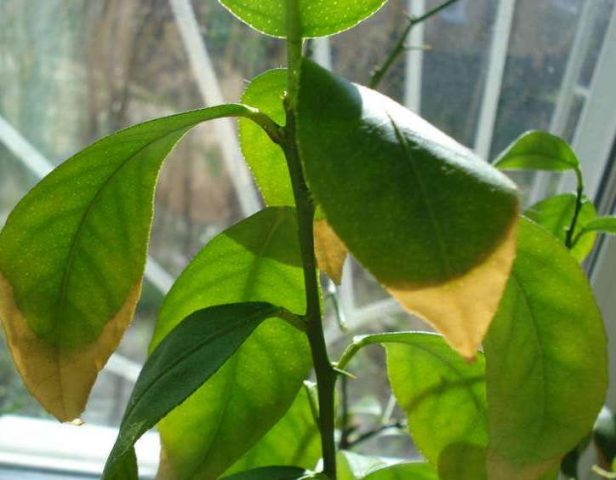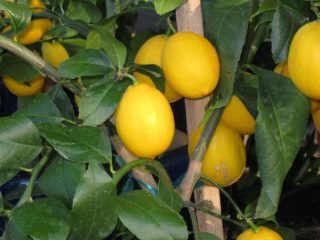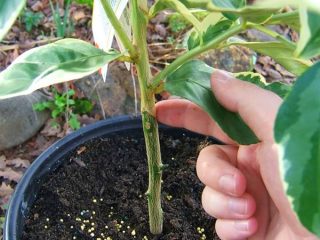Content
Lemon leaves fall off or the tops dry out due to factors unfavorable for the development of the plant. It is important to recognize the cause in time and correct care errors in order to avoid big problems. Yellowing and curling of leaves are prevented by timely preventive measures.
Why does a lemon drop its leaves: a list of possible reasons
Indoor lemons, up to 2 m high, were bred by breeders based on subtropical plants, so growing conditions are not always suitable for representatives of the species. Trees often react radically to gardener’s mistakes: the leaves turn yellow, dry out and fall off. Before starting a demanding crop at home, lovers should study the care rules and avoid the reasons that cause the lemon to turn yellow and shed its leaves.
Violation of the rules of care
Indoor citrus fruits require increased and constant attention. Following the recommendations for caring for lemon will ensure the normal development of the plant, which is noticeable in the condition of the leaves. If they dry out and fall off, the following error options are possible:
- failures in irrigation mode;
- insufficiently nutritious soil;
- noticeable decrease in lighting level;
- unacceptable temperature conditions;
- disease or insect damage.
Is the place chosen correctly?
Lemon leaves also turn yellow if the container is placed in the wrong place. Citrus lovers often take potted plants out onto the terrace or balcony for the summer. Returning indoors in the fall becomes stressful for the lemon, then the tree loses some of its leaves or they begin to dry out. It is advisable to follow the recommendations for placement in the house:
- if the plant is small, the container is placed on the windowsill, removing heat from the batteries with special curtains, as well as cool air from the window;
- it is necessary to block possible drafts so that the leaves do not fall off;
- an adult lemon is placed near the window, and the leaves will not dry if the heat from the radiator is covered with a thick screen;
- It is ideal to place the tree in a cool, bright room without additional lighting, where the temperature is not higher than + 10-12 °C;
- a good place would be an insulated balcony or a special extension similar to a winter garden in country houses.
Violation of rules and watering schedule
If care is taken incorrectly, the lemon at home dries out, and more often the leaves fall off due to insufficient watering. Or, on the contrary, due to waterlogged soil in the tub. Excess moisture leads to compaction of the substrate and soil acidification processes, in which the smallest root processes die off and cannot nourish the entire crown. The tree goes into a state of nutrient conservation. In summer, the tub plant is watered every day or less often - early in the morning, as well as late in the evening. Important! This watering regime will prevent the water from evaporating, and moisture will flow to all the leaves.To retain moisture, use mulch made from perlite, polystyrene foam or crushed bark.
The leaves begin to fall when the lemon has dried out from lack of moisture. Even in favorable wintering conditions, at temperatures from + 10 °C, the soil is rarely but regularly moistened. Only an adult 7-8 year old tree can withstand lack of watering for up to 25 days without losing leaves due to the accumulation of moisture in the wood. The dry soil is moistened gradually: first the top layer is saturated with water, then after a few hours the lower part of the soil is saturated in one or two stages over 2-3 days. This avoids stress on the plant. In winter, water it with water at room temperature, not allowing the earthen ball to dry out, usually twice a week.
Since February, the water has been heated to 35 °C to awaken the plant. Simultaneously with warm watering, the temperature in the room is slowly increased by 2-3 degrees.
Poor or poor quality soil
Loose soil with a neutral reaction is prepared in a lemon container, adding some sand to the ground for lightness. When purchasing ready-made mixtures for citrus fruits, pay attention to the amount of peat. For lemons older than 6 years, take soil with 10% peat. But for a young plant, peat is not added, since the substance increases the acidity of the soil. The earth is enriched by adding:
- 1 tablespoon of wood ash;
- half a handful of crushed hardwood coal;
- 1 tablespoon of tea leaves or coffee grounds.
Microclimate disturbance
If a lemon is in an apartment, it suffers from the heat in winter. The indoor microclimate is compared to a desert in terms of its lack of humidity.Often due to such conditions of increased dryness, lemon leaves fall off in winter. The tree should not be placed near the radiator or the heat source must be covered with a thick screen. At temperatures above + 20 °C, lemon leaves are regularly sprayed with water or wiped with a damp cloth. To increase humidity without special devices and protect the leaves, bowls with water are placed around the plant.
There are also risk factors for citrus fruits:
- Lemon leaves also dry in a room that is too cold, at temperatures below + 10 °C;
- Leaves may fall from the tree if the tub is in a draft area when ventilated;
- The lemon's reaction to sudden changes in temperature day and night, within 8-9 degrees, will be to shed its leaves.
Lack or excess lighting
In the subtropics there is much more sunlight in winter. Lemons do not lose leaves en masse. Therefore, gray late autumn days are another stress factor. A lemon tree falls over in a house if it doesn't have enough light. It is better to place the plant near a window that faces south and install fluorescent lamps nearby.
Violation of the rules and feeding schedule
If you do not care for lemons at home, the leaves turn yellow if the amount of minerals in the soil has decreased. For normal development, citrus, like any other plant, requires a balanced content of macro- and microelements:
- potassium;
- phosphorus;
- nitrogen;
- magnesium;
- iron;
- manganese;
- cobalt and others.
Due to a lack of minerals, even adhering to the watering regime, gardeners complain that the lemon suddenly dropped its leaves.Falling is preceded by visible changes on the leaves, which you need to look closely at:
- yellowish spots appear;
- the leaf becomes paler in color;
- the leaf blade becomes flaccid or curls;
- the edges of the leaves dry out.
Lemon is fed in spring:
- in April-May they give nitrogen preparations or organic matter;
- repeat nitrogen fertilizing in June;
- a little later phosphorus agents are added;
- in early August, fertilize with potassium substances;
- microelements are added monthly in mineral complexes in summer;
- In autumn, complex fertilizers are applied once every 60 days.
Diseases and pests
Lemon leaves may dry out and fall off due to fungal diseases. With Alternaria, the veins turn brown and black, spots appear, and then the leaves fall off. Due to another disease, brown shiny formations are noticeable. Late blight fungi affect the roots if they were in the soil taken for the tub. Diseases are controlled by treating with fungicides containing copper. Sometimes traces of hardening gum are visible on the bark. The area is cleaned, treated with copper sulfate, and sprayed with complex preparations.
Lemon is damaged by insects:
- aphid;
- scale insect;
- citrus Asian psyllid;
- as well as spider mites.
There are special sprays against insect pests; sometimes success is achieved by spraying the leaves with a solution of laundry soap. Mite infestation is recognized by the presence of barely noticeable cobwebs near the leaf cuttings. Microscopic pests on lemons are eliminated using Fitoverm. And then the top soil is replaced.
What to do if a lemon drops its leaves
Noticing that the leaves of the homemade lemon are falling off and the rest are drying up, they resuscitate the tree. After determining the cause, the errors are corrected:
- when the air is dry, humidifiers are installed, the leaves are sprayed or wiped once every 6-8 days, and a bag is pulled over a small tree like a mini-greenhouse;
- do not quickly transfer the lemon from a cold room to a warm one - give it time to get used to it in a room where the temperature gradually rises;
- fill the soil in the tub until it acidifies, transplant it into a container of the same size, checking the roots for rot;
- a diseased lemon whose leaves dry out and fall off is reanimated with the drug “Epin” according to the instructions.
Prevention measures
Homemade lemon leaves will not dry out and fall off if:
- will provide a temperature of + 10-14 °C;
- in a warm room, maintain air humidity and supplementary lighting with special devices;
- water no more than 1-2 times a week;
- anthracnose is treated with Fitosporin;
- for chlorosis, use “Ferovit”;
- feed only in a healthy state - start support with Zircon, HB 101, Epin;
- transplantation is carried out in February-March;
- outside they are treated with fungicides 2 times in the spring.
Conclusion
Lemon leaves fall off when stressed. Only by providing the tree with the required conditions can they rejoice at its good development. Preventive inspections and treatments of citrus fruit, comfortable temperature, sufficient light and proper watering will bring the expected results.













There is a problem with the one-year-old Meer lemon. In the summer everything was fine, in December it began to shed completely healthy leaves, without yellowness, without scale insects and mites. At the same time, the cuttings remain on the branches. The temperature is within limits, it is far from the battery, there is a backlight. I'll try replacing the soil.